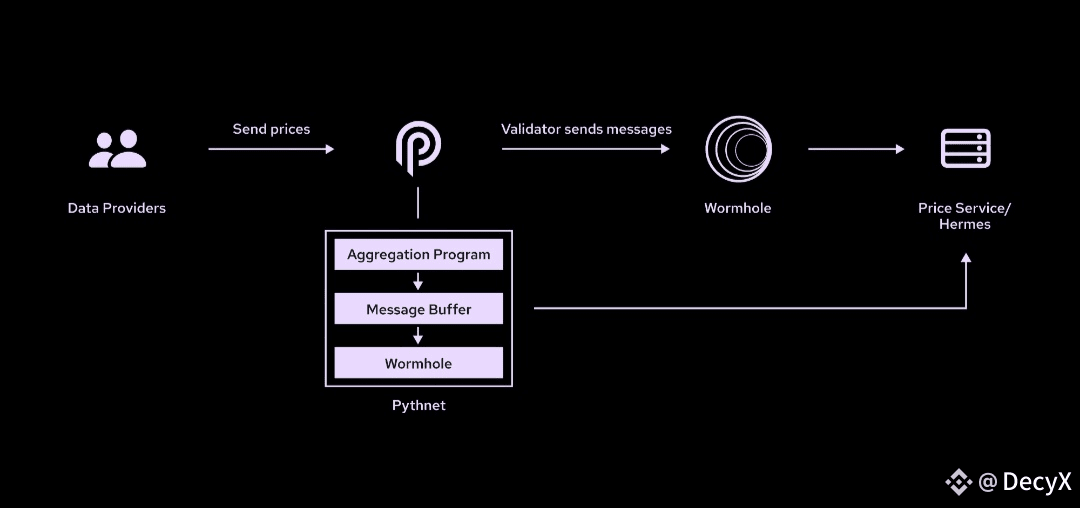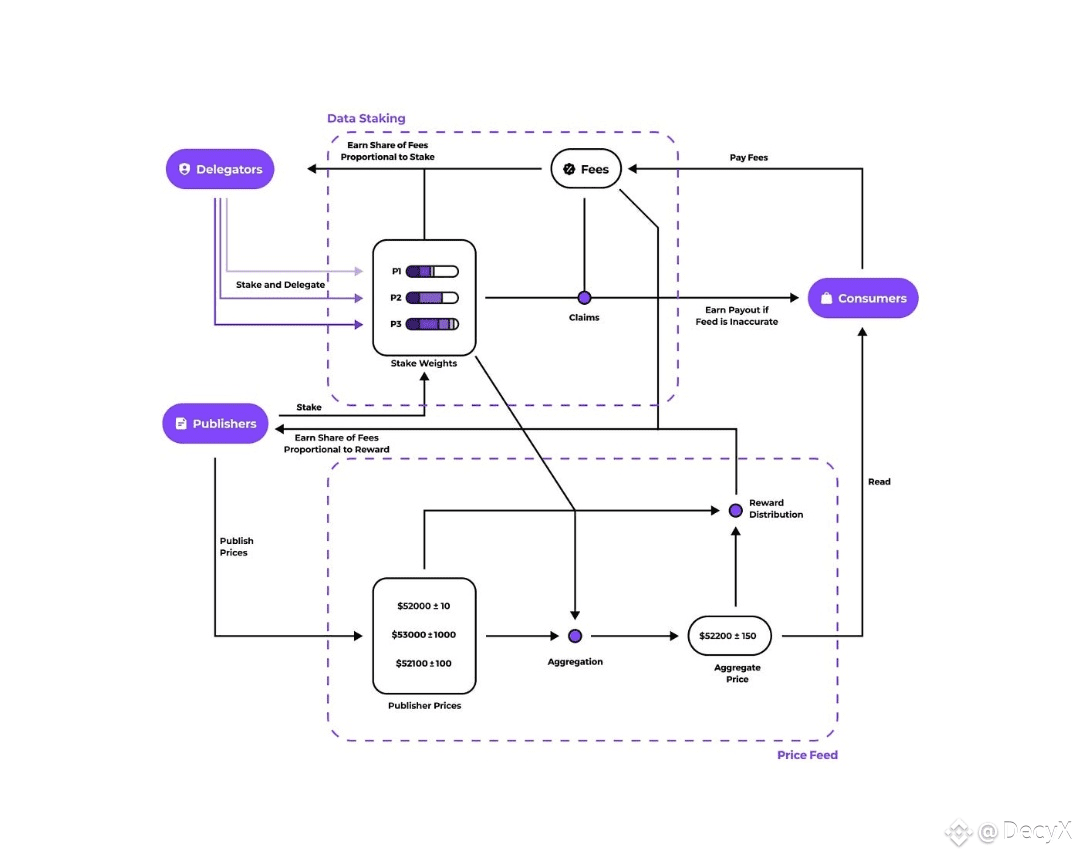In the blockchain industry, data is everything. Every transaction, every contract, and every protocol relies on accurate, timely information to function properly. Yet, one of the most challenging aspects of decentralized finance and Web3 applications has always been sourcing high-quality data in real time. Blockchains are deterministic systems, but they cannot inherently fetch data from the outside world. This gap has been filled by oracles - networks designed to bring external information on-chain. And among these oracle solutions, Pyth Network has emerged as one of the most groundbreaking, offering not only speed and accuracy but also a fundamentally new approach to how data should be delivered to decentralized applications.
The Oracle Problem in Web3
For years, decentralized applications have struggled with the so-called “oracle problem.” Blockchains on their own cannot know what the current price of Bitcoin is, or the latest interest rate in global markets, or even the outcome of real-world events. Oracles act as bridges, providing that data. But traditional oracle systems have often been slow, expensive, or reliant on a handful of middlemen who may not always ensure the highest level of accuracy.
In finance, a delay of even a few seconds in price feeds can mean millions in losses or missed opportunities. For blockchain gaming and prediction markets, inconsistent data feeds can ruin user experiences and undermine trust. Clearly, a more robust and reliable system is needed - one that combines real-time accuracy with decentralization.
This is where Pyth Network sets itself apart.
What Makes Pyth Different
Unlike many oracle providers that rely on third-party aggregators to source data, Pyth taps directly into the first-party data from some of the world’s largest financial institutions, trading firms, and market participants. This means the information delivered to blockchain applications isn’t filtered or delayed - it’s raw, real-time data straight from the source.
This unique design gives Pyth a critical edge. By working with top-tier data providers, the network ensures that price feeds are both timely and trustworthy, something that is especially important in volatile crypto markets where conditions can change in seconds.
Furthermore, Pyth embraces decentralization at its core. With over 90 different data providers contributing, no single entity controls the network. This reduces risks of manipulation and ensures that the information feeding into Web3 applications represents a broad, diverse set of sources.
Real-Time Finance for DeFi
One of the biggest beneficiaries of Pyth’s innovation is decentralized finance (DeFi). Lending platforms, derivatives exchanges, and automated market makers rely heavily on accurate price data. For example, a lending protocol cannot function if it doesn’t know the exact collateral value of an asset in real time. Similarly, decentralized perpetual exchanges need constant updates to execute trades fairly and prevent slippage.
Pyth delivers sub-second price updates across multiple blockchains, ensuring that DeFi protocols can operate with a level of precision and speed previously only available in traditional finance. This bridges a crucial gap between centralized financial markets and decentralized systems, allowing Web3 platforms to scale with confidence.
Beyond Finance: Expanding Use Cases
While Pyth has become a core infrastructure piece for DeFi, its applications go well beyond finance. Blockchain gaming platforms can use Pyth to provide real-world data that powers in-game economies. Prediction markets can settle outcomes quickly and fairly with trusted data feeds. Even NFT marketplaces can benefit from reliable price references when building new tokenized assets or real-world integrations.
The beauty of Pyth lies in its flexibility. It is not limited to one niche but designed to serve as a universal data layer for the entire blockchain ecosystem. Wherever accurate, real-time data is required, Pyth can provide it.
Cross-Chain Reach
Another major strength of Pyth is its cross-chain delivery system. Instead of being locked to a single blockchain, Pyth broadcasts its data across more than 40 different networks, including Ethereum, Solana, BNB Chain, Avalanche, and many others. This multi-chain design ensures that no matter where developers are building, they can access the same high-quality data streams.
This is a game-changer for interoperability. As more blockchains emerge and specialized ecosystems grow, having a reliable, consistent oracle network that works across all of them becomes essential. Pyth is filling this need by becoming a backbone for multi-chain data availability.
Transparency and Trust
Trust is one of the most valuable commodities in Web3. Pyth recognizes this and has designed its system to be as transparent as possible. Data providers sign their contributions cryptographically, and users can trace where the information is coming from. The entire mechanism is visible on-chain, meaning there is no hidden middle layer.
This level of openness gives developers and users peace of mind, knowing that the data powering their applications is not just accurate but also verifiable. In a space where transparency is often the deciding factor between adoption and skepticism, this is a major advantage.
Why Pyth is a Game-Changer for Web3
The blockchain industry has always promised to democratize access to financial systems, information, and digital ownership. But without reliable data feeds, those promises cannot be fully realized. By bringing real-time, first-party data on-chain at scale, Pyth is not just solving a technical issue; it is enabling the very foundation upon which the next generation of decentralized applications will be built.
DeFi platforms can scale securely. Games can build richer, more dynamic environments. Enterprises can trust blockchain data in mission-critical systems. And users can engage with Web3 applications knowing that the information they rely on is accurate and timely.
Looking Ahead
The future of Web3 is going to be shaped by projects that provide critical infrastructure — not just flashy apps or speculative tokens. Pyth is clearly positioning itself as one of those foundational projects. As adoption of blockchain technology grows across industries, the demand for reliable data will only increase. Whether it’s powering decentralized finance, gaming, or entirely new categories of Web3 applications, Pyth is set to be a cornerstone of this ecosystem.
With its first-party data sources, real-time updates, multi-chain reach, and transparent design, Pyth is redefining what oracles can and should be. It is not just about feeding numbers into a blockchain; it’s about enabling a truly connected, trustworthy, and scalable digital economy.
Conclusion
Pyth Network is more than an oracle - it’s a revolution in how data is delivered to blockchains. By leveraging first-party providers, focusing on real-time accuracy, and ensuring multi-chain accessibility, it has established itself as one of the most important pieces of Web3 infrastructure today.
As decentralized applications grow more complex and user expectations rise, projects like Pyth will be the ones that make mass adoption possible. It provides the reliability, transparency, and speed that the blockchain world has been waiting for. And in doing so, Pyth is not just keeping up with the evolution of Web3 - it is helping lead it.